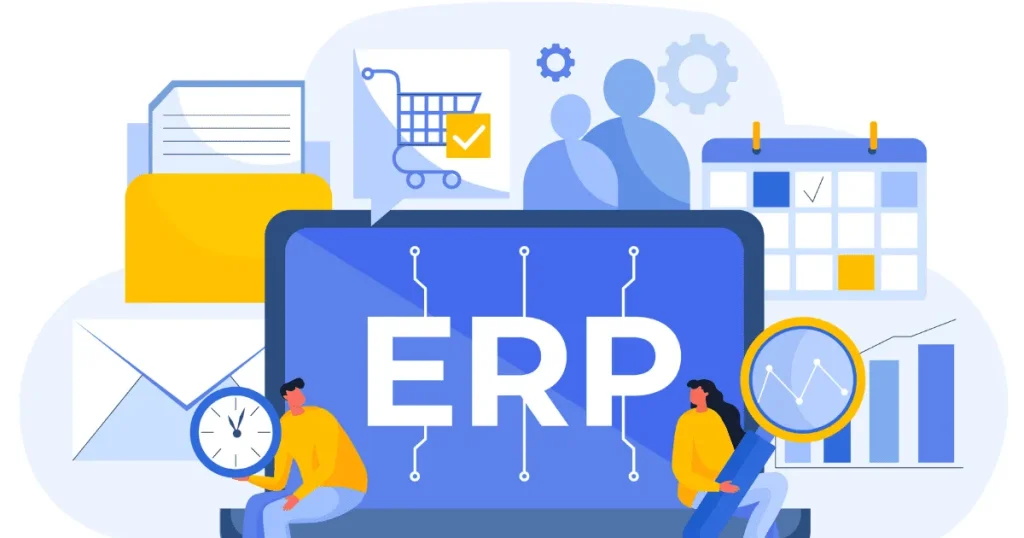Enterprise Resource Planning (ERP) systems are essential to today’s business environment since they improve efficiency and streamline processes in a variety of industries. This blog explores the full form of ERP, its importance, primary goals, implementation steps, benefits, and drawbacks.

What is the Full Form of ERP?
Enterprise Resource Planning is referred to as ERP. It speaks of integrated software systems that oversee and automate key business operations, such as supply chain, manufacturing, finance, human resources, and customer relationship management. ERP facilitates more effective operations and informed decision-making for enterprises by combining these features into a single system.
Why Implement an ERP System?
An ERP system’s implementation can completely change a company by giving it a single platform to handle all of its operations. ERP systems are adopted by businesses for various reasons:
- Streamlined Processes: By automating repetitive operations, ERP systems lower labor costs and boost productivity.
- Increased Data Accuracy: ERP systems that use centralized databases reduce data entry errors and guarantee that all users are working with correct data.
- Improved Cooperation: Information can be shared across departments easily, which promotes improved cooperation and communication inside the company.
- Real-time insights: ERP systems offer real-time data analytics, which helps companies take prompt, well-informed decisions.
- Scalability: ERP systems may expand to handle more users and transactions as a company grows, all without incurring appreciable new expenses.
What are the Primary Goals for the ERP System?
The primary goals of implementing an ERP system include:
- Integration of Business Processes: To create a unified system out of disparate divisions and procedures inside a business.
- Enhanced Productivity: To cut down on duplication, streamline corporate procedures, and boost overall efficiency.
- Better Planning and Reporting: To supply precise and timely data for more effective strategic planning and forecasting.
- Improved Customer Service: To make customer relationship management better by streamlining procedures and improving data accessibility.
- Regulatory Compliance: To assist companies in following industry rules by keeping correct documents and audit trails.
Steps to Implement an ERP System
Implementing an ERP system requires careful planning and execution. Here are the essential steps:
- Establish Goals and Objectives: Clearly state your objectives for the ERP deployment, such as increasing reporting capabilities or efficiency.
- Build a Project Team: Assemble a cross-functional team with members from different departments to ensure that a range of demands and viewpoints are considered.
- Choose the Appropriate ERP Software: Look into and select an ERP solution that fits both your budget and your business’s needs. Take into account elements like vendor support, customization possibilities, and scalability.
- Plan and Design: Draft a thorough implementation plan that specifies the necessary resources, timetable, and important checkpoints.
- Data Migration: Make sure that the existing data is accurately and completely planned before moving it to the new ERP system.
- Training and Change Management: To guarantee seamless adoption, give users thorough training and oversee the transition process.
- Testing: Before going live, do extensive testing to find and fix any problems.
- Go Live and Support: After the team implements the ERP system, they must launch it and provide ongoing support to handle any issues that may arise.
Benefits and Drawbacks of ERP Systems
Benefits:
- Enhanced Efficiency: Process automation saves time and money by lowering operating expenses.
- Centralized Data Management: Collaboration is improved and data silos are reduced when there is a single source of truth.
- Real-time Reporting: Timely decision-making and strategic planning are made possible by instant access to data.
- Regulatory Compliance: ERP systems frequently have components that support adherence to rules and guidelines set forth by the industry.
Drawbacks:
- High Initial Costs: Purchasing software, hardware, and training can be a major upfront expense when implementing an ERP system.
- Complexity: ERP systems can be complicated, and in order for users to navigate them efficiently, they may need intensive training.
- Opposition to Change: When implementing new procedures and systems, employees may be resistant, which can cause problems.
- Challenges with Customization: Although ERP systems are flexible, a great deal of customization might make updates and maintenance more difficult in the future.
Conclusion
Organizations can reap tremendous benefits from the use of an ERP system, which can facilitate collaboration, improve data accuracy, and streamline processes. Businesses must, however, carefully balance the advantages above any potential disadvantages and devote time and resources to thorough planning and implementation. In an increasingly competitive landscape, firms can improve their overall efficiency and achieve their goals by grasping the foundations of ERP systems and adhering to a planned deployment method.
